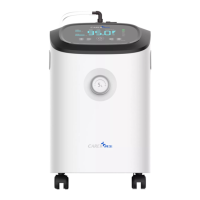I. Alarm classification:
The oxygen concentrator is designed with audible and visual alarm functions, which can alert you to
situations that require your attention.
1. There are two levels of alarms: high-level and medium-level.
High-level alarms indicate the most dangerous conditions for critically ill patients
and are the most serious warnings.
Medium-level alarms are serious warnings.
The alarm characteristics are shown in Table 1 below.
2. Priority level of alarms: high-level alarm> medium-level alarm, that is, when two levels of alarms
exist at the same time, the alarm signal is the sound of high-level alarm.
II. Audible alarm indication:
When an alarm is detected, the oxygen concentrator will make a “drip” alarm sound (The sound pressure
range is 60dB (A) ~ 120dB (A)). Different levels of audible alarms are of different sound frequencies.
1. High-level alarm: Pause after the "Drip-Drip-Drip ------ Drip-Drip” sound. It will sound 5 seconds
later.
2. Medium-level alarm: Pause after the "Drip-Drip-Drip” sound. It will sound 10 seconds later.
3. Priority level of alarms: high-level alarm> medium-level alarm, that is, when two levels of alarms
exist at the same time, the alarm signal is a high-level alarm indicator.
III. Visual alarm indication:
When an alarm event occurs, the alarm indicator will light up.
Table 1 Alarm characteristics
Priority level of alarms: high-level alarm> medium-level alarm, that is, when two levels of alarms exist
at the same time, the alarm signal is a high-level alarm indicator.

